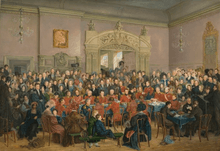Thomas Brereton
Lieutenant-Colonel Thomas Brereton (1782–1832) was an officer of the British Army.
Thomas Brereton | |
|---|---|
| Born | 1782 Kings County, Ireland |
| Died | January 1832 (aged 49–50) Bristol, England |
| Allegiance | Great Britain United Kingdom |
| Service/ | British Army |
| Years of service | 1798–1832 |
| Rank | Lieutenant-Colonel |
| Battles/wars | [Revolutionary wars & Napoleonic Wars] |
Career

He was descended from Sir William Brereton, Chief Justice and Lord High Marshal of Ireland, from the ancient and noble family of Brereton, Cheshire, England. Born in Kings County (now Offaly), Ireland, in 1782. 1798 he received his commission as an ensign in the 8th West India Regiment. 1809 he was promoted to Major and served at the capture of Martinique from the French and Guadelope the following year. He was appointed Brigade Major in 1813 for his relative Major General Robert Brereton, Lieutenant-Governor of St. Lucia. 1814 he was appointed Lieutenant-Governor of Senegal and Gorée and was present during the Méduse tragedy. 1815 he was promoted to Lieutenant-Colonel of the Royal African Corps. 1819 he was appointed to the command of the Cape Town garrison until 1823 when he retired to England to become Inspecting Field Officer for the Bristol recruiting district.
At the time of the 1831 Reform riots in Bristol he was in charge of the troops. The riots started on the Saturday and lasted for three days and though Colonel Brereton only lost control on the Sunday due to lack of troops he still managed to put down the rioting early on Monday morning before the arrival of the reinforcements he had requested. Despite this, he was controversially court-martialled in January 1832, during which he committed suicide. Twice a widower he died leaving four children.[1]
Depictions in film
The 1978 children's paranormal TV drama The Clifton House Mystery was a ghost story based on the circumstances of Brereton's death. The plot revolved around a family moving into an old house in Bristol that finds a long-dead skeleton in a hidden room. After some unexplained incidents, they become convinced that a ghost connected in some way with the Bristol Riots of 1831 is haunting the house. After checking local records, they realize that it is the ghost of a dragoon commander who was court-martialled for his handling of the riots, and who later disappeared without a trace. The ghost is named "George Bretherton" in the TV series. One of his descendants, named "Mrs Betterton", had sold the house to the family, but was allegedly unaware of the hidden room and its contents, referring only to a vague family scandal that happened generations ago.[2]
Depictions in fiction
The 1906 historical novel Chippinge (sometimes Chippinge Borough) by Stanley J. Weyman is based on the background to the 1831 Bristol Riots and culminates in a detailed description of those riots and Colonel Brereton's part in them. The main fiction in that description is that the important role played by Major Digby Mackworth is ascribed to the hero, Arthur Vaughan.
References
- Brereton, J. A. The Readeption of Colonel Brereton.
- "The Clifton House Mystery". IMDb. 2014. Retrieved 6 September 2014.
- The Readeption of Colonel Brereton, John Brereton
![]()
External links
- "Suicide of Colonel Brereton". The Spectator Archive. 14 January 1832. Retrieved 6 September 2014.
- "Extracts from The Bristol Gazette on a riot in Bristol, 3 November 1831". National Archives. 2014. Retrieved 6 September 2014. (Catalogue ref: PRO HO 40/28)